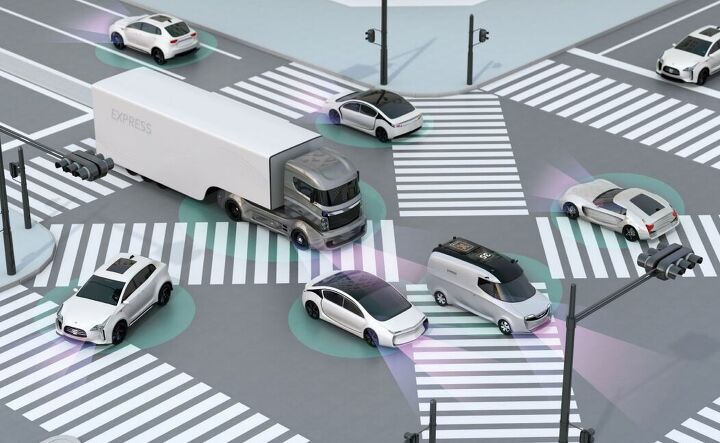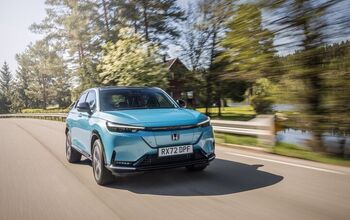NHTSA's Updated Autonomous Safety Guidance Doesn't Actually Offer Any

On Tuesday, Transportation Secretary Elaine Chao outlined the Trump administration’s “Vision for Safety 2.0” at the University of Michigan’s Transportation Research Institute in Ann Arbor. The document is a collection of non-binding requests to manufacturers and a promise that they can go hog-wild with their autonomous vehicle testing, at least as far as the feds are concerned.
In a deluge of policy updates, the National Highway Traffic Safety Administration tweaked its vision for safety, claiming it was responding to the recent increase in the number of road accidents.
While Obama-era guidelines weren’t particularly robust, the Trump administration has essentially built a technical-sounding framework aimed at destroying regulatory red tape. Ironically, the government seems to have gone out of its way to ensure it stays out of the way. In some respects, it has to. The speed of development is beginning to happen at a rate where any outside bureaucracy would have difficulty keeping pace. Chao said the guidance would remain flexible, ready to adapt to the changes as they come. But it is also without teeth, promoting development and the future promise for safety at the expense of any meaningful oversight.
Did the Department of Transportation and NHTSA sell themselves out to industry or do they actually think giving automakers carte blanche on autonomous testing was the best thing for public safety?
In the short term, it’s easy to argue that it makes things less safe — but only marginally. Safety 2.0 eliminated the Obama administration’s request for manufacturers to submit a 15-point safety assessment prior to putting an autonomous vehicle on the road and replaced it with jack squat. If a manufacturer wants to provide the DOT with such a document, companies are more than welcome to do so. But it isn’t mandatory.
The document also tells individual states to mind their own business and prepare for test vehicles on their highways and roads. Uniformity would be a boon to R&D departments, as California is notoriously strict about regulating self-driving vehicles while Michigan doesn’t seem to mind autonomous testing whatsoever.
Other key points of update include a changing of language to better reflect the evolving tech, encouraging new entrants and ideas into the industry, making regulatory processes more nimble to help match the pace of private sector innovation, and supporting industry innovation while encouraging open communication “with the public and with stakeholders.”
To paraphrase, Vision 2.0 is really about bolstering business. While that’s great in some respects, some consumer advocacy groups are more than a little pissed. Consumer Watchdog was already highly critical of Congress’ approval of self-driving tech and expressed additional concerns in response to Chao’s address.
“This isn’t a vision for safety,” said John M. Simpson, Consumer Watchdog’s privacy project director. “It’s a road map that allows manufacturers to do whatever they want, wherever and whenever they want, turning our roads into private laboratories for robot cars with no regard for our safety.”
Several House Democrats have also been outspoken on just how soft the Department of Transportation’s guidance is. House Democrats Frank Pallone Jr. of New Jersey and Jan Schakowsky of Illinois issued a joint statement accusing Vision 2.0 of being regressive, claiming “the administration chose to cave to industry and pressure the states into not acting.”
Chao does have her supporters, however. In attendance at Tuesday’s announcement was Mark Riccobono, president of the National Federation of the Blind, who has repeatedly praised fully autonomous vehicles as “an unprecedented opportunity to bring equal access to people with disabilities.”
Riccobon said those opportunities could not be emphasized enough for the 7 million blind citizens currently living within America’s borders.
Whether or not that was ever the intent of automakers is debatable, however. The kind of autonomy required to allow a blind person to “drive” is still a long way off (and would also require a non-touchscreen interface to facilitate their needs). It’s something to strive for, but present-day licensing laws would have to change if they were ever to be more than a passenger.
Likewise, the NHTSA is pushing the technology as a way to keep elderly people behind the wheel. This is another worthy cause but poses further problems. Anyone who has a family member with even mild dementia will tell you that teaching them how to utilize an unfamiliar digital interface is next to impossible — limiting the application of the technology to a particularly tech-savvy minority. That is, at least until the systems have been around long enough to have an aged community grow into it.
Even with all of Chao’s talking points on improving safety, Vision 2.0 doesn’t actually do much to improve it in the short term. Instead, it is banking on an unregulated automotive industry hurrying to the finish line and delivering safer technologies on a longer timeline.
Vision for Safety 2.0 is available for perusal at the NHTSA’s website (goofy graphics and all), but Chao indicates Vision 3.0 is already being worked on. Keep in mind this is still all voluntary, but establishes framework for legislators and the industry to work from.
Last week, the House of Representatives passed a bill that would allow automakers to place as many as 25,000 autonomous cars on the road apiece — even if some features don’t meet current NHTSA safety standards. The limit would rise over four years, permitting each manufacturer to field 275,000 driverless cars by the end of the period.
The House bill is in largely in line with Vision 2.0, as it would require safety assessments but permission to test would not be required. States would also be mandated to follow federal regulations.
“Safety must always be number one but we need to take a look at this new technology and how it augments, furthers safety,” Chao said. “As the technology advance and the department gathers new and more information from stakeholders and consumers, we will continue to refine and update this guidance.”
[Source: Mlive.com][Image: NHTSA]

A staunch consumer advocate tracking industry trends and regulation. Before joining TTAC, Matt spent a decade working for marketing and research firms based in NYC. Clients included several of the world’s largest automakers, global tire brands, and aftermarket part suppliers. Dissatisfied with the corporate world and resentful of having to wear suits everyday, he pivoted to writing about cars. Since then, that man has become an ardent supporter of the right-to-repair movement, been interviewed on the auto industry by national radio broadcasts, driven more rental cars than anyone ever should, participated in amateur rallying events, and received the requisite minimum training as sanctioned by the SCCA. Handy with a wrench, Matt grew up surrounded by Detroit auto workers and managed to get a pizza delivery job before he was legally eligible. He later found himself driving box trucks through Manhattan, guaranteeing future sympathy for actual truckers. He continues to conduct research pertaining to the automotive sector as an independent contractor and has since moved back to his native Michigan, closer to where the cars are born. A contrarian, Matt claims to prefer understeer — stating that front and all-wheel drive vehicles cater best to his driving style.
More by Matt Posky
Latest Car Reviews
Read moreLatest Product Reviews
Read moreRecent Comments
- Corey Lewis It's not competitive against others in the class, as my review discussed. https://www.thetruthaboutcars.com/cars/chevrolet/rental-review-the-2023-chevrolet-malibu-last-domestic-midsize-standing-44502760
- Turbo Is Black Magic My wife had one of these back in 06, did a ton of work to it… supercharger, full exhaust, full suspension.. it was a blast to drive even though it was still hilariously slow. Great for drive in nights, open the hatch fold the seats flat and just relax.Also this thing is a great example of how far we have come in crash safety even since just 2005… go look at these old crash tests now and I cringe at what a modern electric tank would do to this thing.
- MaintenanceCosts Whenever the topic of the xB comes up…Me: "The style is fun. The combination of the box shape and the aggressive detailing is very JDM."Wife: "Those are ghetto."Me: "They're smaller than a Corolla outside and have the space of a RAV4 inside."Wife: "Those are ghetto."Me: "They're kind of fun to drive with a stick."Wife: "Those are ghetto."It's one of a few cars (including its fellow box, the Ford Flex) on which we will just never see eye to eye.
- Oberkanone The alternative is a more expensive SUV. Yes, it will be missed.
- Ajla I did like this one.


































Comments
Join the conversation
I am sure Tesla and Uber will not in any way take advantage of this situation by beta testing their code on their unsuspecting customers.
"... The document also tells individual states to mind their own business and prepare for test vehicles on their highways and roads." The "States' Rights" hypocrites strike again.